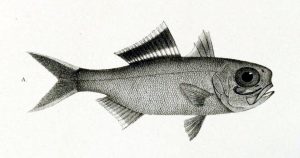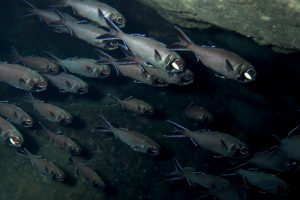Jägers, P., Wagner, L., Schütz, R. et al. Social signaling via bioluminescent blinks determines nearest neighbor distance in schools of flashlight fish Anomalops katoptron. Sci Rep 11, 6431 (2021).
Below a flashlight fish’s eyes is an organ that provides the ideal conditions for a special partnership. Bioluminescent bacteria live inside these organs. Here bacteria find the necessary nutrients to grow and reproduce. Flashlight fish cannot control how much light is created by these bacteria. However, it does have special flaps that block the bioluminescent light. According to a new study published in Scientific Reports in March of 2021, the blinking patterns of this fish are used to communicate with members of its own species.

To find out how flashlight fish communicate with members of their own species, scientists conducted three separate experiments – two in a lab, and one in the wild. First, they placed a fish dummy inside a tank and introduced a single flashlight fish inside the tank. The faster that the fish dummy flashed its lights, the closer the flashlight fish stayed to the test dummy. In a second experiment, scientists placed thirteen LED lights around a circular tank and turned them on one after the other. Flashlight fish followed the LED lights and moved faster when the LED light flashed at a faster interval. From these two experiments, scientists determined that flashlight fish use light to follow fish of their own species and that fast blinking patterns are a signal to move faster and stay closer to other fish.
These two findings are important for two main reasons. First, flashlight fish spend most of their time in dark underground caves and holes in the ocean. They come out to the surface to feed on zooplankton during dark moonless nights. Therefore, in such dark settings, light is an important way to communicate with members of its own species. Second, flashlight fish are a type of schooling fish. When schooling fish feel threatened by a predator they stay close to one another and move quickly. The fast blinking pattern is one way in which flashlight fish signal other members of the species that danger is looming.

Diving at night off the coast of Indonesia, scientists waited for a school of flashlight fish to get close so that they could test their experiment in the field. Once the fish were close, they startled the school of fish using red dim lights and filmed their escape. From the film, scientists confirmed what they had seen in the lab – the fish blinked faster and stayed closer together.
In ray-finned fish, the largest group of fish, bioluminescence has evolved independently at least 27 times. However, the majority of these bioluminescent fish live in deep areas where it is difficult for scientists to do experiments. While flashlight fish are closely related to deep bioluminescent fish, they live in relatively shallow waters. Thus, they are the perfect species to study so that we further our understanding of bioluminescence and learn how fish survive in dark areas of the ocean.
Hello! I am a science communicator who loves sharing stories about the ocean. In my free time, I enjoy running, spending time outdoors, doing puzzles and sipping on coffee while reading a good book. I am also an educator at the Museum of Science in Boston.


